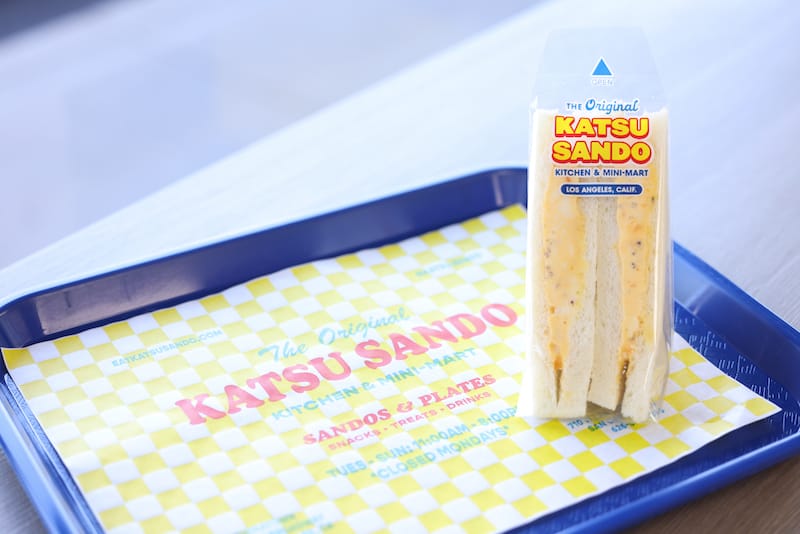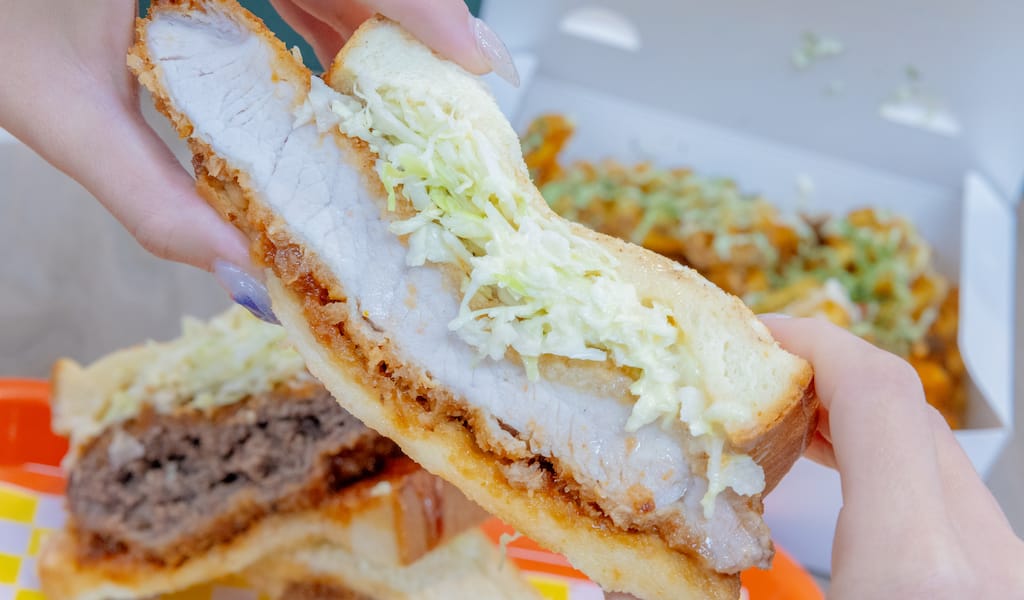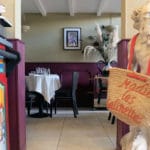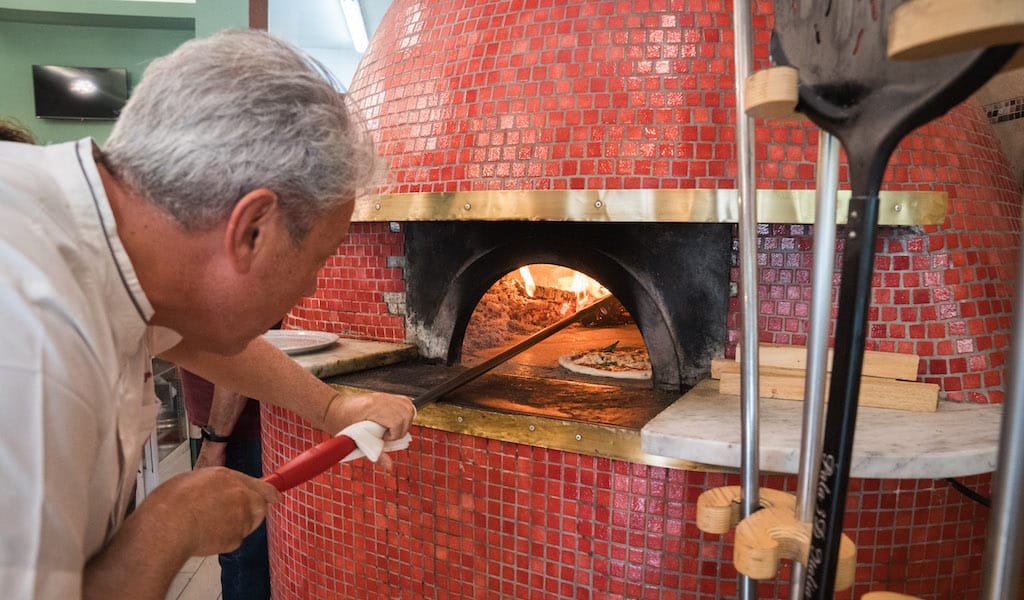In the grab-and-go section of Katsu Sando’s second L.A. location hangs a T-shirt that reads: “Krispy and thicc sandos bruh.” That’s not a typo. The extra “c” in “thicc” refers not only to the audibly loud crunch you get from the casual Japanese restaurant’s panko-crusted pork and chicken cutlets, but to the generous fillings and fat slices of honey-milk bread that make up its eponymous dish, the katsu sando.

Katsu is a fried cutlet, an iconic element of Japanese cooking. But sando is not just a shorter way to say sandwich. It is the translation of a Japanese interpretation of a “Western-inspired sandwich” – a fitting star dish for this L.A. spot. The bread itself (shokupan), made with milk and honey, is meant to be an elevated version of fluffy American sandwich loaves like Wonder Bread. It’s baked in-house, and hugs thick fried pork cutlets (tonkatsu), chicken cutlets (torikatsu), ground beef patties (menchi katsu), shrimp patties (ebi katsu) or egg salad.
Colorful and cheeky, with a checkerboard motif featuring cute animal mascots, Katsu Sando opened its first location, in L.A.’s Chinatown, in 2020. The concept has remained unchanged: Japanese comfort food disguised as an American fast-food franchise. They’ve now expanded with a second spot in the San Gabriel Valley (SGV), a district that’s become a vibrant hub for many of L.A.’s Asian communities.

When redlining – which confined minorities to certain areas through racially discriminatory practices – ended in 1968 with the Fair Housing Act, increasingly more first- and second-generation Asians and Asian-Americans from Japan, China, Korea, Thailand, Vietnam and the Philippines were allowed to rent and buy outside of neighborhoods like Chinatown or Little Tokyo. The SGV was a newly developed, nearby suburb at the time, and the Asian and Asian-American communities quickly began buying homes and opening restaurants and business there. Now it is a hotspot for Asian food in the city. And it’s no surprise that L.A. born, Korean-American chef and Katsu Sando founder Daniel Son would make it home to the restaurant’s second location in 2023.

Born in 1987, Daniel starting working in food early, helping out at his father’s restaurant as a young teen, and training under its sushi chef. In his early twenties, he moved to Japan after graduating from the Culinary Institute of America at Hyde Park. Son’s devotion to the katsu sando actually began in Japan, where the sandwich is a staple of Japanese grab-and-go culture, commonly found in the country’s konbini. While konbini (also spelled conbini) might translate to “convenience store,” it’s much more than that. These 24-hour shops offer a wide array of ready-to-eat meals and desserts, including curries, sushi, cakes, blended ice drinks and the ever-popular white bread sandwiches. Many of these treats have their own cult followings, some for their funky, innovative wrapping or brilliant self-heating packaging.
These konbini hold a special place for Son. “During my time living and working in Tokyo,” he wrote to us, “the biggest gift and comfort to me were visiting the 24/7 convenient stores. While I marveled at how simple and delicious they are, I also felt there was a large gap between our convenient stores back home. This inspired me to reintroduce them by way of Katsu Sando.” Son would scarf down fast-food sandwiches from such konbini while apprenticing long shifts under Chef Seiji Yamamoto at Nihonryori RyuGin. Under the glow of the Tokyo restaurant’s three Michelin stars, he was eventually swept off to Copenhagen’s Noma before coming back to L.A. to work on his own projects.

Curry, tonkatsu and the konbini itself are all very popular Japanese fixtures in Korea, as well. And Son has added a touch of his own dual identity to his restaurant, with Korean snacks making an appearance in the casual spot’s grab-and-go counter: crunchy Turtle Chips, Pepero biscuit sticks and Homerun Ball chocolate crackers, to name a few. Freshly prepared egg salad sandos or sweet sandos with fruit salad and whipped cream also make an appearance, as well as must-have staples like Japanese soft drinks Ramune and Calpico, and onigiri (triangular seaweed-wrapped rice balls).
“Some people expect the conbini foods to be a flavor bomb,” Son writes. “But it’s really seasoned and prepared for you to enjoy in a light and easy eating manner.” He recommends grabbing a couple of different items to make a meal. His favorite combo: onigiri, an egg salad sando and a fruit sando – “for a light but hearty lunch on the go!”
But the katsu sando is the star attraction here, and namesake for good reason. One bite, and it lives up to the hype. The tender and juicy meat features an audibly loud crunch from a beautifully dense layer of namo (fresh) panko. This type of bread crumb commonly used in Japanese cooking is fresh and not dried, making for a lighter and more delicate texture. The honey-milk bread that holds everything together is thick and pillowy. Shredded cabbage in yuzu kosho (chili) dressing and a layer of katsu sauce create an acidic, umami finish with each bite.

For those looking for pure crunch, hold the bread, any protein on the sando menu can be turned into a curry plate with rice (a common dish to heat up in a konbini). Don’t forget the Wagyu curry dipping sauce. Finally, instead of milkshakes, the restaurant specializes in Japanese shaved ice (kakigōri) featuring seasonal specialty milk-based flavors like pumpkin, lychee, melon and strawberry.
Katsu Sando sits at the intersection of L.A.’s two biggest food legacies: fusion and fast-food. Add to that SGV’s local status as an Asian culinary hub and the addictive crunch of Son’s sandwiches, and it’s no surprise this quirky spot has become a big hit.
Ulysses SalcidoUlysses Salcido
Published on December 08, 2023
Related stories
September 21, 2023
Naples | By Giuseppe A. D’Angelo
NaplesThe hordes of pizza lovers who descend on Naples usually head for Via dei Tribunali in the city’s historical center, famed for its parade of pizzerias. If they arrive by train, they will exit the central station, go straight through Piazza Garibaldi and head right for the Centro Storico, where the guidebooks they carry always…
July 27, 2020
MarseilleFrom Gascogne’s prized ducks to the buckwheat gallettes of Bretagne, each chunk of France has its distinct food traditions. In Marseille, the capital of Provence, the recipes brim with the region’s olive oil, garlic and tomatoes as well as plenty of Mediterranean fish. On menus around town, you’ll find an anchoïade here or artichauts à…
Discover multicultural Marseille on our walk!
February 13, 2020
MarseilleUpdate: This venue is now closed. Once the stomping ground of sailors and the Corsican mafia, Marseille’s oldest district, Le Panier, has evolved into a tourist hub and creative neighborhood. Its winding streets are peppered with ateliers (like blade smiths, chocolatiers and painters) and the 17th-century facades are canvases for colorful murals. One of them,…





















































































